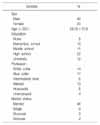Abstract
Purpose
To translate and culturally adapt a Korean version of the Neck Disability Index (NDI), as well as to validate its use in Korean patient.
Materials and Methods
The NDI was linguistically translated into Korean and the prefinal version was assessed and modified by a pilot study. The Korean version was tested on 60 patients with degenerative cervical spine disease to verify the reliability and validity. The test-retest reliability, internal consistency, concurrent validity, and construct validity were examined by a comparison with the VAS and SF-36.
Results
The intraclass correlation coefficient of test-retest reliability was 0.927. The reliability estimated by the internal consistency reached a Cronbach's alpha of 0.82. The correlation of the NDI with VAS was r=0.489 (p=0.002) and correlation between NDI and SF-36 was r=-0.44 (p<0.01). The physical health component score of SF-36 showed a high correlation with the NDI as well as a high correlation between VAS and mental health component scores of SF-36.
References
1. Ackelman BH, Lindgren U. Validity and reliability of a modified version of the neck disability index. J Rehabil Med. 2002. 34:284–287.

2. Agarwal S, Allison GT, Agarwal A, Singer KP. Reliability and validity of the Hindi version of the Neck Pain and Disability Scale in cervical radiculopathy patients. Disabil Rehabil. 2006. 28:1405–1411.

3. Aslan E, Karaduman A, Yakut Y, Aras B, Simsek IE, Yaglý N. The cultural adaptation, reliability and validity of neck disability index in patients with neck pain: a Turkish version study. Spine. 2008. 33:E362–E365.
4. BenDebba M, Heller J, Ducker TB, Eisinger JM. Cervical spine outcomes questionnaire: its development and psychometric properties. Spine. 2002. 27:2116–2123.
5. Bourne RB, Maloney WJ, Wright JG. An AOA critical issue. The outcome of the outcomes movement. J Bone Joint Surg Am. 2004. 86:633–640.

7. Cleland JA, Fritz JM, Whitman JM, Palmer JA. The reliability and construct validity of the Neck Disability Index and patient specific functional scale in patients with cervical radiculopathy. Spine. 2006. 31:598–602.

8. Cook C, Richardson JK, Braga L, et al. Cross-cultural adaptation and validation of the Brazilian Portuguese version of the Neck Disability Index and Neck Pain and Disability Scale. Spine. 2006. 31:1621–1627.

9. Dawson J, Fitzpatrick R, Carr A. Questionnaire on the perceptions of patients about shoulder surgery. J Bone Joint Surg Br. 1996. 78:593–600.

10. Deyo RA, Andersson G, Bombardier C, et al. Outcome measures for studying patients with low back pain. . Spine. 1994. 19:Suppl. S2032–S2036.

12. Guillemin F, Bombardier C, Beaton D. Cross-cultural adaptation of health-related quality of life measures: literature review and proposed guidelines. J Clin Epidemiol. 1993. 46:1417–1432.

13. Hains F, Waalen J, Mior S. Psychometric properties of the neck disability index. J Manipulative Physiol Ther. 1998. 21:75–80.
14. Han CW, Lee EJ, Iwaya T, Kataoka H, Kohzuki M. Development of the Korean version of Short-Form 36-Item Health Survey: health related QOL of healthy elderly people and elderly patients in Korea. Tohoku J Exp Med. 2004. 203:189–194.

15. Jeon CH, Kim DJ, Kim SK, Kim DJ, Lee HM, Park HJ. Validation in the cross-cultural adaptation of the Korean version of the Oswestry Disability Index. J Korean Med Sci. 2006. 21:1092–1097.

16. Jordan A, Manniche C, Mosdal C, Hindsberger C. The Copenhagen Neck Functional Disability Scale: a study of reliability and validity. J Manipulative Physiol Ther. 1998. 21:520–527.
17. Kim DY, Lee SH, Lee HY, et al. Validation of the Korean version of the oswestry disability index. Spine. 2005. 30:E123–E127.

18. Lagattuta F, Falco F. Braddom R, editor. Assessment and treatment of cervical spine disorders. Physical Medicine and Rehabilitation. 2000. Philadelphia: Saunders;762–791.
19. Miettinen T, Leino E, Airaksinen O, Lindgren KA. The possibility to use simple validated questionnaires to predict long-term health problems after whiplash injury. Spine. 2004. 29:E47–E51.

20. Mousavi SJ, Parnianpour M, Montazeri A, et al. Translation and validation study of the Iranian versions of the Neck Disability Index and the Neck Pain and Disability Scale. Spine. 2007. 32:E825–E831.

21. Pietrobon R, Coeytaux RR, Carey TS, Richardson WJ, DeVellis RF. Standard scales for measurement of functional outcome for cervical pain or dysfunction. Spine. 2002. 27:515–522.

22. Trouli MN, Vernon HT, Kakavelakis KN, Antonopoulou MD, Paganas AN, Lionis CD. Translation of the Neck Disability Index and validation of the Greek version in a sample of neck pain patients. BMC Musculoskelet Disord. 2008. 9:106.

23. Vernon H, Mior S. The neck disability index: a study of reliability and validity. J Manipulative Physiol Ther. 1991. 14:409–415.
24. Vos CJ, Verhagen AP, Koes BW. Reliability and responsiveness of the Dutch version of the Neck Disability Index in patients with acute neck pain in general practice. Eur Spine J. 2006. 15:1729–1736.

25. Wheeler AH, Goolkasian P, Baird AC, Darden BV 2nd. Development of the Neck Pain and Disability Scale. Item analysis, face, and criterion-related validity. Spine. 1999. 24:1290–1294.




 PDF
PDF ePub
ePub Citation
Citation Print
Print








 XML Download
XML Download